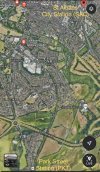a few points from a regular user:
1) 4 car is overkill, but it’s cheaper than having anything else. I use the trains in the peak, and have never, ever had to share a bay of 4.
2) the 350s enable the trains to do 16 mins end to end punctually. 319s rarely could.
3) various proposals over the years for busways, passing loops, tram conversion etc. None have come remotely close to having a business case, and they never will. The main reason is that most people in St Albans have no need to go to Watford (hospital excepted - for which car is by far the preferred mode) and vice versa. The traffic from intermediate stations is relatively small, especially at the St Albans end.
4) if desired, a tram could get up Holywell hill - average gradient is 5.8% with a peak of 8%. Sheffield has steeper sections. It couldn’t turn onto Victoria St though, so would have to go up to Hatfield Rd and head to the station there. But it would be extraordinarily expensive for minimal benefit.
5) the best hope for the line is a half hourly service, which could (just) be done with one unit and no loop. Note that even if a loop was miraculously free, a half hourly service that requires an extra unit and crew doesn’t come remotely close to covering its marginal costs (£2m+). To make it half hourly with one unit would need 3-4 min turnarounds (done routinely), 30 sec dwells (requires DCO), a couple of linespeed improvements and 2 level crossing upgrades (pref closures), and skip stopping at least two stations on every other service - probably 2 of the St Albans end stations of Park St, How Wood and Bricket Wood. That would have a marginal cost of a few hundred thousand pounds, which probably would be covered by revenue. And avoid the costs of a second unit, another 4 sets of crew, and the loop.
That thread was a belter.

